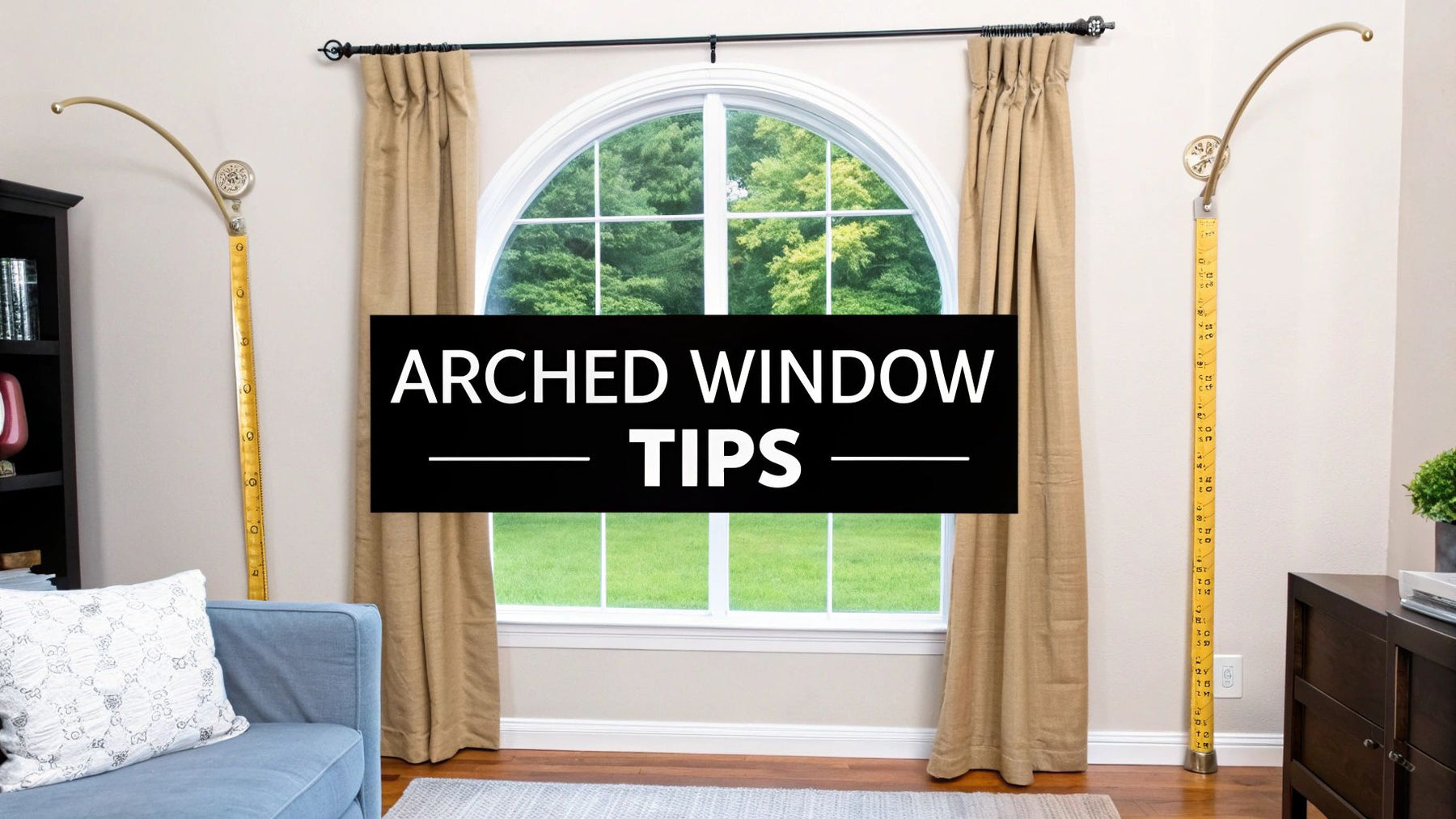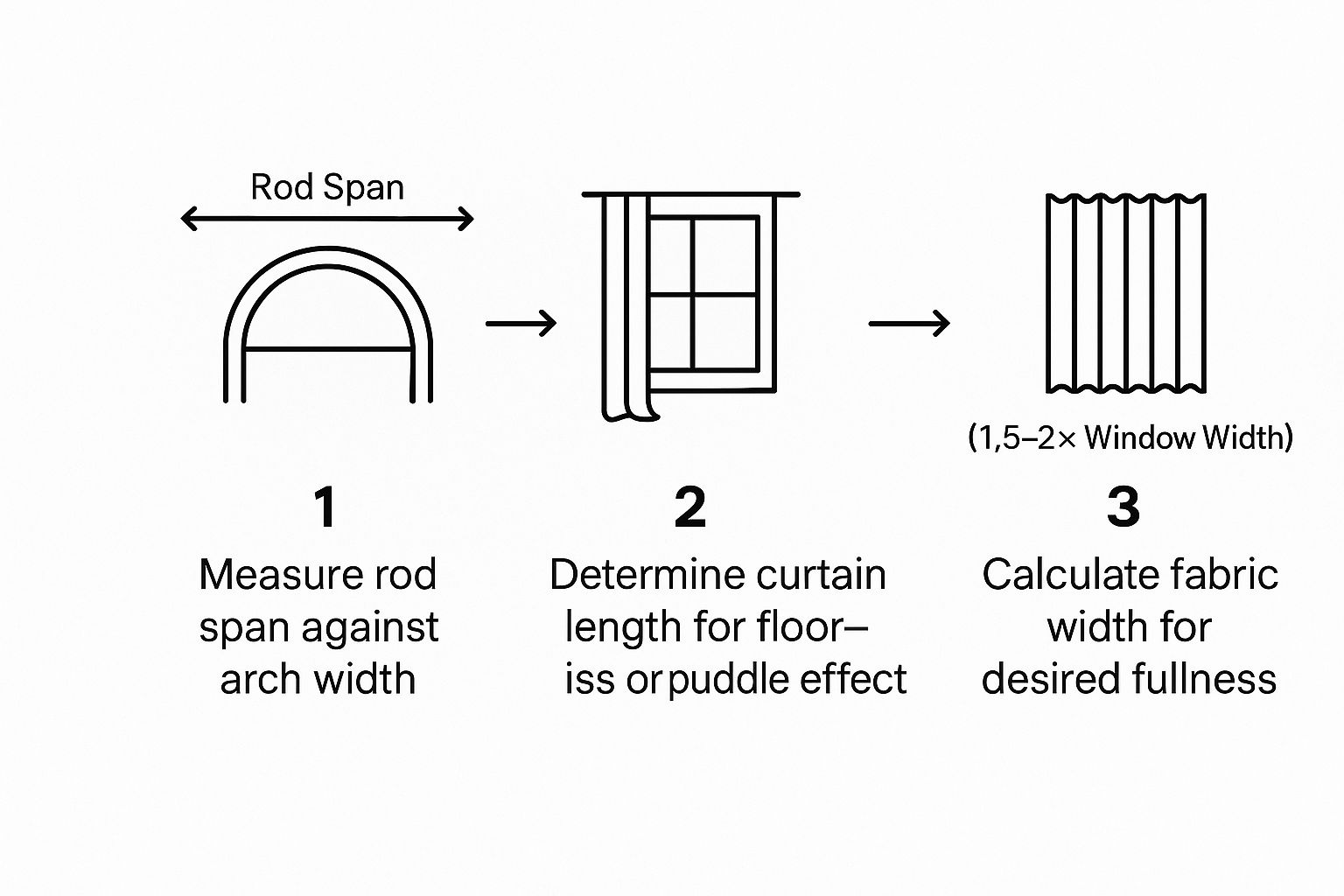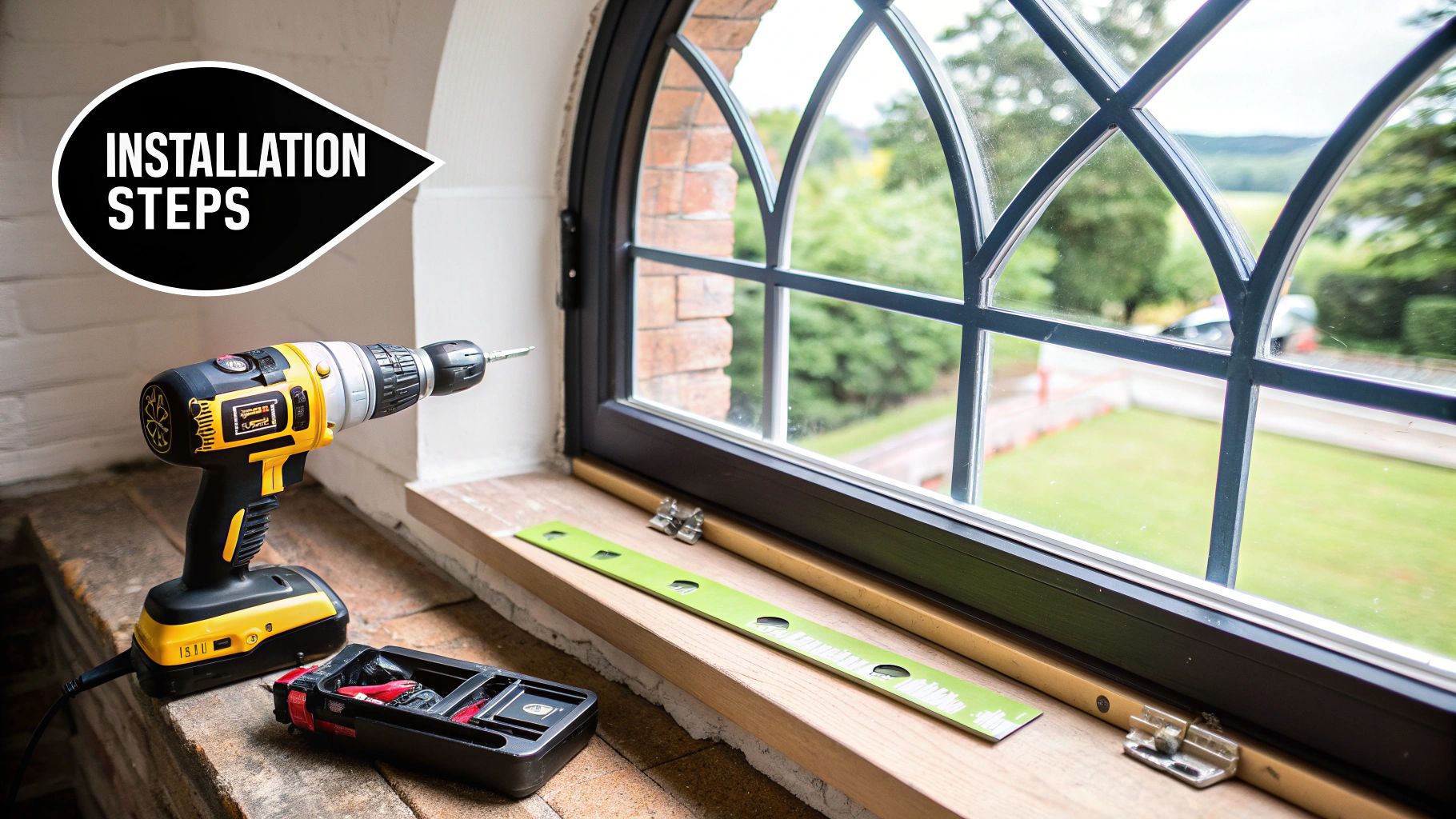
How to Hang Curtains on an Arched Window: 3 Stylish Methods
Arched windows bring a stunning architectural elegance to any room, but they can be tricky to dress. Knowing how to hang curtains on an arched window properly can turn this challenge into a show-stopping feature. You've got three fantastic options: mount a straight rod high above the arch for drama, follow the curve with a custom rod, or use stationary panels to frame the view.
Each approach enhances the window's unique shape, turning it into a beautiful focal point. This guide will walk you through choosing the best method, measuring correctly, and installing your curtains like a pro.
Table of Contents
- Why Dress an Arched Window?
- 3 Ways to Hang Curtains on an Arched Window
- How to Measure for Arched Window Curtains
- Step-by-Step Installation Guide
- Common Mistakes and Pro Styling Tips
- Frequently Asked Questions
Why Bother Dressing an Arched Window?
An arched window is more than just a source of light; it's a statement piece. Leaving it bare can feel unfinished, but the wrong treatment can hide its special character. The goal is to enhance the architecture, not fight it.
When done right, dressing an arched window offers several key benefits:
- Accentuates Height: The right curtains draw the eye upward, making ceilings feel taller and the room grander.
- Adds Softness: Fabric introduces a layer of warmth and sophistication, balancing the hard lines of the window frame.
- Controls Light and Privacy: Even stationary panels can soften harsh sunlight, giving you control without sacrificing the shape.
Understanding the Unique Challenges
Arched windows defy standard hardware and simple installations. Off-the-shelf solutions often don’t work, which is why a thoughtful approach is so important. For more inspiration, check out our guide on curtain ideas for large windows.
One popular solution involves mounting a curtain rod high above the window. While about 85% of window treatments are for standard frames, designers have clever tricks for the rest. In fact, roughly 15% of designers dealing with arches opt for this high-mount method. This often means placing the rod 15-20 inches above the window’s base with extra-long curtains.
Before you start, it's helpful to see how other non-standard shapes are handled. The problem-solving for curved glass is explored in this ultimate guide to blinds for round windows, and many principles overlap.
Quick Guide to Arched Window Curtain Styles
| Hanging Method | Best For | Key Challenge |
|---|---|---|
| High Straight Rod | Creating height and drama; using standard curtains. | Can obscure the arch top when curtains are closed. |
| Curved/Custom Rod | Showcasing the window's shape; fully functional curtains. | Expensive and requires precise, custom fabrication. |
| Stationary Side Panels | Framing the window as a focal point; minimal light obstruction. | Purely decorative; offers no privacy or full light control. |
Choosing Your Arched Window Curtain Strategy
Deciding how to hang curtains on an arched window is about picking a strategy that clicks with your room's personality. Your choice will dramatically influence the room's height, light, and overall vibe.
You can go bold by mounting a straight rod high above the arch, creating a grand effect. Or, embrace the architecture with a custom-curved rod. A third option is to frame the view with stationary side panels, leaving the beautiful arch fully exposed.

Method 1: Go High and Mighty with a Straight Rod
Mounting a straight curtain rod well above the arch is the most popular and often most dramatic approach. By extending the rod at least 6-10 inches beyond the window frame on each side and placing it closer to the ceiling, you create a powerful illusion of height.
Insider Tip: I suggest hanging the rod about halfway between the top of the arch and the ceiling molding. This trick draws the eye upward, making the whole space feel more expansive.
A huge benefit is flexibility—you can use standard curtain panels, which helps your budget. The only trade-off is that closed curtains will cover the arch, so it’s best for spaces where you plan to keep them open most of the time.
Method 2: Embrace the Curve with a Custom Rod
For fully functional curtains that don't hide the architectural detail, a custom-bent or flexible rod is the answer. This hardware is designed to follow the window's curve, allowing your curtains to mirror its elegant shape.
This strategy is perfect for maintaining the window's integrity while providing privacy and light control. It’s a sophisticated look for formal dining rooms or studies. The main drawback is cost and complexity; custom hardware is a specialty item. This is why only 38% of homeowners report satisfaction with arched window treatments, versus 92% for standard windows, according to industry surveys.
Method 3: Frame the View with Stationary Panels
If your goal is to add softness and color without blocking the view, stationary panels are your best friend. This minimalist approach involves mounting short, decorative rods on either side of the window, usually just below where the arch begins.
This method is purely decorative, turning your window into a beautifully framed piece of art. It’s perfect for spaces where privacy isn't a concern. Since the panels are there to accent, fabric choice is key. We've put together a full guide on how to pick drapes that complement this style.
Comparing Arched Window Curtain Hardware
| Hardware Type | Typical Cost | Installation Difficulty | Best Use Case |
|---|---|---|---|
| Straight Rod | $ | Easy | Creating height and drama; budget-friendly. |
| Custom Curved Rod | $$$ | Difficult (Pro Recommended) | Maintaining the arch's shape with functional curtains. |
| Stationary Side Rods | $$ | Moderate | Decorative framing when privacy is not a concern. |
How to Measure for Arched Window Curtains
Getting your measurements right is the most critical part of dressing an arched window. An arch demands precision. A small error can result in an awkward "high-water" look or panels that feel out of place. My best advice? Measure twice, buy once.
Before you touch a tape measure, decide on your hanging method. The measurements for a high-mounted straight rod are completely different from those for a custom curved one.
Determining Rod Length and Placement
For a high-mounted straight rod, the goal is to create an illusion of height and width. A common mistake is choosing a rod that's too narrow, which cramps the window and blocks light.
- Measure Width: Measure the absolute widest part of your window frame.
- Add Extension: Add at least 6-10 inches to each side. A 60-inch wide window needs a 72-80 inch rod. This extra length lets the curtains stack back completely, exposing the arch and maximizing light.
- Determine Height: A great rule of thumb is to place the rod about halfway between the very top of the arch and your ceiling or crown molding.
This infographic helps visualize the key steps for a perfect fit.

As you can see, the process moves logically from rod position to curtain length, and finally to fabric fullness.
Calculating Curtain Length and Fullness
Once your rod placement is marked, it’s time to determine curtain length. Forget standard sizes; you’ll almost certainly need longer panels for a polished look.
Expert Takeaway: Curtains for arched windows should always touch the floor. A slight "kiss" where they graze the surface looks tailored, while a "puddle" of 1-3 extra inches adds drama. Anything shorter looks like a mistake.
To find your perfect length, measure from where the bottom of your rod will be down to the floor. For more detailed guidance, see our guide on how to measure for window curtains.
Next, ensure the total width of your curtain fabric is 1.5 to 2 times the width of your window. This ensures they look lush and full. Industry trends show 78% of successful installations use machine-washable fabrics, while 67% of arched window owners opt for sheers to keep rooms bright. You can find more insights on these material and measurement considerations on TheHues.com.
Time to Hang Your Curtains
You've planned, measured, and chosen your hardware. Now it’s time to bring it all to life. Installing curtains on an arched window requires patience, but it's a project you can tackle yourself.
First, gather your tools: a drill, a level, a pencil, and the right wall anchors for your wall type (drywall, plaster, or masonry). Don't skip the anchors—they ensure your rod stays secure without sagging.

Step 1: Mark Your Bracket Placement
When figuring out how to hang curtains on an arched window, precision is key. If mounting a straight rod, always use your level to ensure the rod will be perfectly parallel to the floor, not the window frame. Window frames in older homes can be slightly crooked.
Pro Tip: Before drilling, use painter's tape to create a temporary line on the wall where the rod will go. This lets you stand back and check the placement from across the room before committing to holes.
Mark the spots for your brackets carefully. For wider windows, a center support bracket is needed to prevent bowing. Most manufacturers suggest a support bracket for rods spanning more than 48 inches.
Step 2: Install a Straight Rod Above the Arch
Once marked, the rest is straightforward. Drill pilot holes, insert wall anchors, and screw the brackets firmly into place. With the brackets up, hang your curtains on the rod and set it in place.
- One Last Check: Rest your level on the brackets one last time to be certain they’re perfectly aligned.
- A Smooth Glide: If using curtain rings, ensure they can slide easily along the entire rod. C-shaped rings are designed to pass over support brackets without snagging. You can find stylish curtain hardware at JoeyzShopping.com.
Step 3: Make a Template for a Curved Rod
If you chose a custom curved rod, creating a perfect template is essential. Tape a large piece of craft paper over the arch and carefully trace the exact curve of the window from the inside.
This template is the blueprint you or your fabricator will use to bend the rod into the perfect shape. It's the secret to ensuring the rod hugs the window's curve without any awkward gaps, making all the difference for a flawless finish.
Common Mistakes and Pro Styling Tips
Even with perfect measurements, small missteps can keep your arched window treatment from looking spectacular. Knowing how to hang curtains on an arched window is the first step; styling them like a pro is what truly elevates the room.
The most frequent mistake is choosing a curtain rod that’s too narrow. This forces curtains over the glass even when open, blocking light and making the window feel cramped. Another common error is hanging curtains that are too short. The "high-water" look visually chops down your walls and makes the setup feel like an afterthought.
Avoiding Common Pitfalls
The solutions are simple but make a massive impact.
- Go Wider with Your Rod: Always extend your curtain rod at least 6-10 inches beyond the window frame on each side. This gives panels a place to "stack back" when open, framing the window instead of suffocating it.
- Let Them Touch the Floor: Curtains should either "kiss" the floor or "puddle" with an extra 1-3 inches of fabric. Anything in between looks unfinished. When in doubt, buy longer and have them hemmed.
A Quick Fix: If your curtains are a touch too short, try using ring clips instead of a rod pocket. This can add an extra inch or two of length, which might be just enough to save them.
Pro Styling for a Polished Look
Once you’ve nailed the fundamentals, add final layers of style to turn your window into a true focal point.
One of my favorite techniques is layering sheer and blackout curtains on a double rod. This gives you total control over light and privacy. You can leave sheers closed for a soft, diffused glow, then draw the blackout panels for complete darkness. You might find more inspiration in these eco-friendly styling tips.
Finally, don't forget finishing touches. Elegant tie-backs or holdbacks create a graceful drape that beautifully frames the arch. And choose your finials (the decorative end caps) with intention. A simple cap finial offers a modern look, while something more ornate can enhance a traditional space.
Frequently Asked Questions
Can I use a regular curtain rod for an arched window?
Yes, you absolutely can. Using a standard straight curtain rod is the most popular—and often most dramatic—method. The key is to mount it several inches above the highest point of the arch, closer to the ceiling. This creates a stunning illusion of height and is typically more budget-friendly than custom hardware.
How do I cover the arch for privacy?
Covering the arch itself for privacy or light control requires a custom solution. The best options include:
- Cellular or Honeycomb Shades: These can be custom-cut to fit the arch perfectly and offer excellent insulation.
- Shutters: Custom interior shutters provide amazing light control and a timeless architectural feel.
- Layering: Use decorative curtain panels on the sides and install a custom shade just for the arch itself.
Should curtains on an arched window touch the floor?
Yes, for the most polished look, curtains on an arched window should either just "kiss" the floor or puddle slightly with 1-3 inches of extra fabric. Since you are hanging the rod high to create a grand statement, curtains that stop short can look awkward and unfinished. Always measure from your final rod position down to the floor to ensure you buy the correct length.
What are good alternatives to curtains for an arched window?
If curtains aren't the right fit, you have several excellent alternatives. Custom interior shutters can be built to the exact shape of your arch. Honeycomb or cellular shades are another go-to choice as they can be custom-cut and offer great insulation benefits. You can also mount Roman shades just below the arch, covering only the rectangular part of the window and leaving the arch itself exposed as a beautiful design feature.
Ready to find the perfect hardware and drapes for your arched window? At Joey'z Shopping, we offer a curated selection of high-quality window treatments to bring your vision to life. Explore our collection and start your project today
